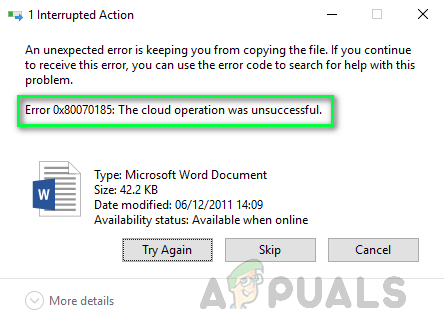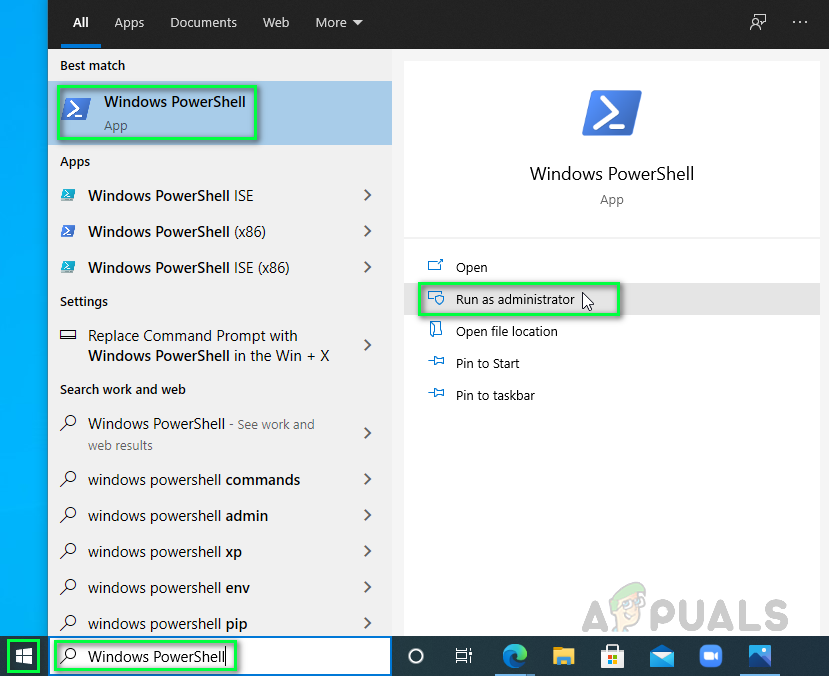How To Fix OneDrive Error Code 0x80070185 on Windows 10?
This error occurs when one of the persons tries to access the shared files, available on Microsoft OneDrive. This error causes opening and synchronization failures on all the shared files. Due to this, the user fails to access the shared files online. Furthermore, the user fails to download these shared files on his/her device as well.
It makes the situation quite troublesome for educational and business organizations as people are failing to access important files for their working on Microsoft OneDrive. Not to mention, It is also a problem for personal use. The error alarms the user with the message “Error 0x80070185: The cloud operation was unsuccessful.”. This error keeps the user from copying a file (locally to his/her device). The error notification is as follows:

What Causes OneDrive Error code 0x80070185?
Our technical researchers drafted a list of causes that may be causing the error under consideration as it becomes easy to rectify the problem once the cause is known. The list is as follows:
- Increase in File Size: The file sometimes gets ~2kb’s bigger as soon as you open it for the first time (right after the file is downloaded before it opens in Office). Opening it a second time only fixes it if the file has been saved locally on a hard drive.
- Damaged Setup File: It has been observed that this error may occur due to a corrupt OneDrive installation because of the damaged OneDrive setup file that you are going to install the setup from. This file may be damaged or incomplete due to unsuccessful download or third-party interference.
- Corrupt Certificates: Sometimes, when network certificates or protocols are not correctly configured then you may face the error under consideration. Inappropriate configuration of the certificates may lead to connection failure with Microsoft servers, ultimately causing the error under consideration.
- Corrupt Cache: With time, trash items fill up the system’s cache, and hence, the overall performance of the PC gets affected. Effected performance may also lead to a different type of errors in different applications and there is a possibility that It may lead to the error under consideration for OneDrive.
- Windows Registry: It has been observed that the error may occur due to a problem in the Windows Registry settings. The Windows Registry is a hierarchical database that saves low-level settings for the Microsoft Windows operating system and for applications that opt to use the registry and OneDrive is one of those applications.
- Third-party Software: It is obvious that the installed antivirus may be blocking your file or files saved on the OneDrive cloud. Antivirus is sensitive third-party software. If the file you are trying to access may contribute to being a potential threat (even a little bit), your antivirus will block its access, ultimately causing this error.
- Windows Firewall: As OneDrive works when the internet works then it is understood that if the OneDrive Software is blocked from Windows Firewall, it won’t be able to have internet access which will cause errors just like the one under consideration.
- No Internet access: Technically, as OneDrive works with an internet connection, which may be interrupted due to bad or unavailable internet that creates an uncomfortable environment leading to this error.
Let us jump to the solutions now to get rid of this problem.
Solution 1: Reset OneDrive
As discussed in the causes, a corrupted cache can alter the system’s performance and application’s execution. Also, network certificates may have been inappropriately configured. From technical research, it has been concluded that resetting your OneDrive using normal Run commands may actually solve your problem as resetting OneDrive restores the default settings for both network certificates and application settings. Many users were able to solve this problem by following this method. The steps are as follows:
- Press Windows + R keys on your keyboard to open the Run dialog box. The Run dialog box is used to execute common windows commands which help us to accomplish different tasks i.e. navigation, reset, etc.
- Copy-paste the command given below in the search bar and click OK. This will initiate the reset process for Microsoft OneDrive. This process may take time so wait until it gets finished. A good practice is to wait for five minutes after executing the command to reset Microsoft OneDrive.
Note: Microsoft OneDrive icon will disappear after executing this command. Once the reset procedure gets completed, it will reappear. The time interval depends on your Network and PC specifications.%localappdata%\Microsoft\OneDrive\OneDrive.exe /reset

Resetting Microsoft OneDrive - Though Microsoft OneDrive should relaunch after reset on its own (Its icon appears in the system icon tray) but sometimes it may not. In that case, press Windows + R keys on your keyboard again to launch the Run dialog box. Copy-paste the following command and click OK. This will run Microsoft OneDrive manually. As soon as the Microsoft OneDrive runs, its icon will appear in the system icon tray.
%localappdata%\Microsoft\OneDrive\OneDrive.exe

Running Microsoft OneDrive Manually - Try accessing/downloading your files now on Microsoft OneDrive. You shouldn’t face any problems now. Although, if the same error occurs while accessing some file other than the one you were previously accessing then the good approach would be to map a SharePoint Document Library as a Network Drive to solve the problem. Please go through the next solution for guidance and instructions in this case.
Solution 2: Map a SharePoint Document Library as a Network Drive
As mentioned above, if the above solution resolves the error for the file you were trying to access but the same error occurs when you try to access another file then a good approach would be to map a SharePoint Document Library as a Network Drive to solve the problem. This will create a network hub that will enhance the Network’s strength and its accessibility, ultimately eliminating the error under consideration. This proved to be a helpful solution as reported by many users online. To map a SharePoint Document Library as a Network Drive, follow these steps:
- Open OneDrive on your browser, log in to your Microsoft account and open the file library you are trying to access.
- Select the URL of the document and press Ctrl + C keys on your keyboard to copy the URL of the document library to the clipboard.

Copying the Document Library URL - Click Start, search File Explorer and open it. This will open the File Explorer window which is a very common file manager in Windows 10.

Opening File Explorer - Right-click on Network, located in the left pane window, and select Map network drive… This will open a Map Network Drive window that will further require some information from your end i.e. Drive Label, Local Folder Location, etc.

Opening the Map Network Drive Window - Click on Connect to a Web site that you can use to store your documents and pictures. This will open Network Location Wizard which will help us map the OneDrive Folder Library as a Network Drive.

Opening Add Network Location Wizard - Keep clicking on Next until the Specify the location of your website window comes by. Press Ctrl + V keys on your keyboard to paste the OneDrive File Library URL you copied earlier in step one in the search bar. Make sure to replace http:// (In some cases, https://) with \\ and click Next.

Agreeing to the License & Agreements - Give Network Location a name as you desire. By default, the name is the same as the name of the OneDrive Document Library, and click Next > Finish.
- Click Start, search Windows PowerShell, and click on Run as administrator. This will open Windows PowerShell utility with admin privileges. Windows PowerShell Utility is a task automation and configuration management framework developed by Microsoft.

Running Windows PowerShell as Administrator - Copy-paste the following code in Windows PowerShell and press Enter on your keyboard. This will initiate the looping process through all the documents available in the Network Drive we just created (linked with OneDrive File Library).
{ $_.FullName Get-Content -Path $_.FullName -first 1 | Out-Null }
Looping through all the Documents in the Network Drive - Restart your PC to save the changes.
- Try accessing/downloading your files now on Microsoft OneDrive or Network Drive. This should finally fix your problem.




